Accounts of Roszak’s post-war sculpture have often emphasised the literary qualities of his work. According to the art historian H. Harvard Arnason, Roszak ‘discovered in literature an endless source of wonderful ideas and images as inspirations for sculptural concepts’.1 Titles of his post-war works reference the work of writers including Edgar Allan Poe, Herman Melville and others.2 Roszak had also studied philosophy, and others have observed his engagement with figures such as Jean-Paul Sartre and Carl Jung.3 It is undoubtedly correct to say that Roszak’s ‘rapport with culture was intellectual and highbrow’, but for viewers of his art in the 1950s, Roszak’s unique brand of mutated figuration, with its strange conflation of animal, vegetable and mineral forms, might also have evoked more popular sources.4 Setting aside Roszak’s own declared literary interests and focusing instead on the reception of his art, this section will explore the affinities between his sculpture and the creatures of post-atomic catastrophe that proliferated in contemporary science-fiction books and movies.
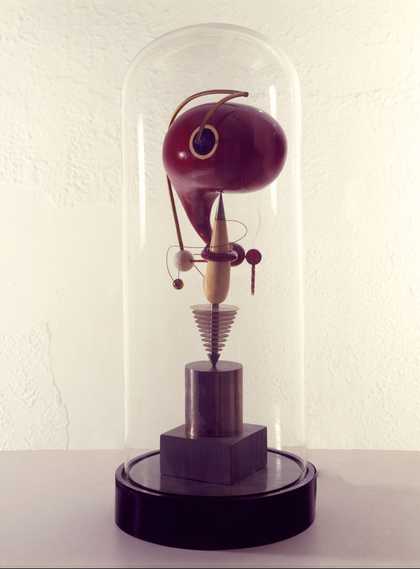
Fig.1
Theodore Roszak
Chrysalis 1937
Theodore Roszak Estate, New York
© The estate of Theodore Roszak
This is complicated territory, as Roszak provided limited evidence to connect his post-war sculpture to what is often referred to as the ‘golden age of science fiction’, which began in the late 1940s and gave birth to a cinematic tradition that would draw on many of its stories. But it takes little imagination to connect Roszak’s earlier constructivist work such as Chrysalis 1937 (fig.1) to the rockets that illustrated the stories of science-fiction writers such as H.G. Wells and Jules Verne. Indeed, it is known that Roszak had read Wells’s War of the Worlds (first published in 1898) and was fascinated by the idea of time machines.5 As an art student in his twenties he owned a copy of The Metropolis of Tomorrow (1929) by Hugh Ferriss, the influential architectural draftsman whose vaporous renderings of a high-rise future defined modernist fantasies of the city (see fig.2).6 Eventually Roszak would himself contribute to such streamlined imaginings by working on display elements for industrial designer Norman Bel Geddes’s ‘Futurama’ pavilion for General Motors at the New York World’s Fair in 1939 (see fig.3).7

Fig.2
Hugh Ferriss
Crowding Towers 1929
Published in Hugh Ferriss, The Metropolis of Tomorrow, New York 1929, p.63
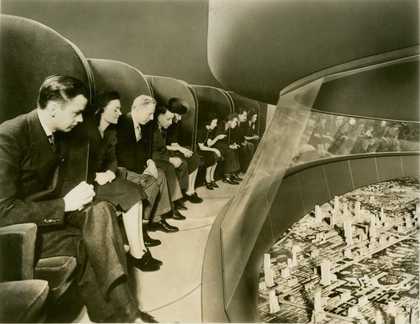
Fig.3
Norman Bel Geddes
General Motors – Futurama – Visitors in Moving Chairs Viewing Exhibit 1935–45
Photograph
New York Public Library, Digital Collections, New York
Roszak’s engagement with visions of interwar urban utopia certainly shared some of its futurism with the more dystopian elements of his post-war work. The continuities might be observed, for example, by comparing his now destroyed Tower Construction of 1932 (fig.4) with his design for the MIT Bell Tower and Spire 1955 (fig.5). Roszak imagined the former as a ‘monumental structure in the gothic spirit and with the modern accoutrements ... a receiving and sending station scanning the cosmos for messages from outer space’, and the same description could easily stand for the soaring antenna atop Eero Saarinen’s cylindrical chapel, even if its pitted surface appears to have survived a more turbulent history than its pre-war counterpart.8 Describing the MIT project in 1956, Roszak imagined his design in similar terms; its ‘essence is “Gothic”’ and like a ‘gargoyle’, he explained, assimilating the character of the spire but ‘thrusting them upwards into space’.9
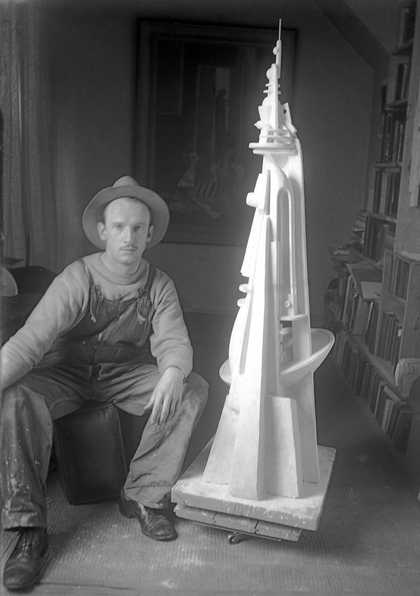
Fig.4
Theodore Roszak
Self-Portrait with Tower Construction 1931–3
Photograph
© The estate of Theodore Roszak
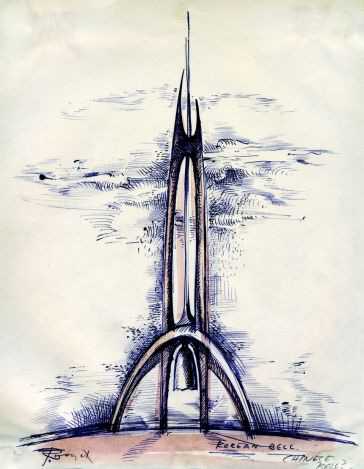
Fig.5
Theodore Roszak
MIT Bell Tower and Spire 1955
Massachusetts Institute of Technology, Cambridge, Massachusetts
© The estate of Theodore Roszak
If Roszak’s pre-war fantasies suggested a high-speed future of a distinctly Buck Rogers variety, their weathered post-war progeny drew more on the forms of the natural rather than the man-made world, shifting to what art historian Daniel Wheeler has characterised as the artist’s ‘tortured, angst-ridden, direct metal hybrids of plant and animal forms’.10 As curator Lisa Phillips has observed of welded sculpture more generally, this was a shift that echoed the character of post-war science fiction:
The drama of the possible extinction of the human species is very much in evidence in the sculpture of the late forties and fifties, as it is in its popular culture counterpart, science fiction novels and films. Like many monsters of science fictions films, new sculptural images were based on imaginative crossbreedings of dinosaurs, predatory plants, pods, and blobs – nature gone berserk, grotesque mutations that represent an attempt to exorcise unbearable terrors by invoking and subduing them.11
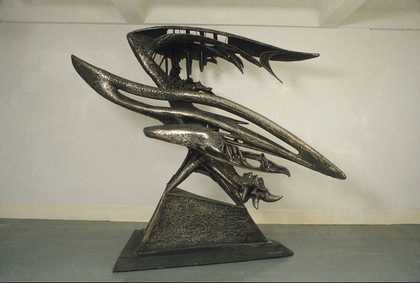
Fig.6
Theodore Roszak
Night Flight 1958–62
Theodore Roszak Estate, New York
© The estate of Theodore Roszak
In the case of Rozsak, Phillips goes so far as to compare his Night Flight 1958–62 (fig.6) – a sculpture whose upward winged sweep and wedge-shaped base might be seen to refine the form of The Unknown Political Prisoner (Defiant and Triumphant) – to a still from the Japanese monster film Rodan (1956). Describing how the theme of the ‘apocalyptic bird’ was much in evidence in 1950s sculpture, Phillips notes that ‘atavism was one response to the growing dilemma of man’s relationship to technology’.12
Like fossils that serve as records of some unknown ancient trauma, Roszak’s encrusted animal and vegetal forms evoke the perils of contemporary apocalypse and fall squarely within a streak of cultural responses to developments in science and technology at mid-century. As critic Howard Devree saw it, the ‘spiky, savage, threatening forms’ of 1950s sculpture embodied ‘the unease of so many present day artists to world tensions’.13 Returning to forms of the natural world served to allegorise more modern fears: ‘Many of the sculptors have been led to look back, or feel back, to times when the threat to man came from nature’, Devree observed on the occasion of Roszak’s 1956 retrospective at the Whitney Museum of American Art. ‘They embody in their metal sculpture suggestion of primitive plant or undersea forms, primeval animals, or totemic images and ritual masks, and to evoke non-figurative constructions to embody their reactions toward the conceived threats of life today.’14
Roszak’s sculptural technique was central to its affective force. ‘The painters and photographers of our day have joined in this voyage of discovery into the world of decay, and a new microcosm or mutilated surfaces has sprung up’, noted art historian Alfred Neumeyer of Roszak and his peers. ‘This new sense for the aesthetic value decaying of mutilated materials has led sculptors to use a highly effective tool, the blow torch ... [which] can imbue metal with the appearance of old ship sides, anchors, or barbed wire entanglements, and facilitates the suggestion of such shapes as aggressive crustaceans, thorny underbush, tangled creepers or intertwined bodies.’15 For Neumeyer, the recourse to forms redolent of bodily disfigurement echoed the inescapable memory of the Second World War: ‘It seems natural enough that suffering man should find identifying symbols for the experiences of war and mass murder of his age’.16
In a 1955 lecture, Roszak noted of his post-war work that ‘instead of looking at densely populated man-made cities, it now begins by contemplating the clearing’, imagining urban obliteration as the ground zero from which his sculpture grew.17 ‘Instead of serving up slick chromium’, the artist went on, ‘its surfaces are scorched and coarsely pitted.’18 At the most basic material level, Roszak’s use of an oxyacetylene torch determined his sculptures to have been borne of violent heat. As one of his assistants described, the technique itself produced ‘disconcerting explosions’, providing their making with some of the same sense of danger that their forms ultimately evoked.19 Critic Katharine Kuh would later go so far as to claim that Roszak’s ‘corroded surfaces and amputated forms intentionally suggest destruction ... as close to the burned flesh of Hiroshima as certain marble carvings were to the philosophy of Greece’.20 It is this connection between the materiality and subject matter of Roszak’s sculpture that had curator (and judge of the International Sculpture Competition) Andrew Carnduff Ritchie summarise Roszak’s work in a 1952 publication as ‘molten forms in welded and brazed metal, violent or cataclysmic in theme’.21
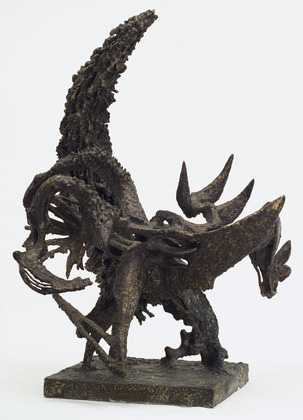
Fig.7
Theodore Roszak
Spectre of Kitty Hawk 1946–7
Museum of Modern Art, New York
© The estate of Theodore Roszak
It is in this sense that Roszak’s art can indeed be connected to the character of New York School painting. ‘After the bombing of Hiroshima’, art historian Michael Leja has explained of abstract expressionist painting, ‘the belief in the equivalence of modern and primitive terror became conventional’.22 When artists such as Mark Rothko, Adolph Gottlieb and Barnett Newman used the primitive to evoke terror and brutality, it was the fate of twentieth-century man with which their art grappled. Leja has described how film noir can be understood as one popular corollary of such themes, but the work of Roszak and other sculptor-welders materialised such anxieties in more visceral and flagrant ways. As the artist explained of his Spectre of Kitty Hawk 1946–7 (fig.7), it was both an aircraft and a ‘reincarnation of the pterodactyl’, trying to ‘metaphorically ... relate at once several things in remote periods of history’.23 Roszak conceived that his sculpture would require viewers to contend with the nature of time itself, which speaks to the ‘multi-directional temporality’ that Robert Slifkin identifies in the preceding chapter of this publication as so central to the character of Roszak’s monuments.24
As science fiction narratives imagined a world in which the human race was returned to a new stone age, Roszak made sculptures that looked like they were from a future plunged into the past. This was far from mere fantasy in the early 1950s. To take just one example, the sensational discovery of the coelacanth – the prehistoric fish that was understood as a ‘living fossil’ – was an example of a creature that appeared to traverse great gulfs in time. A cast of the coelacanth was exhibited at New York’s Museum of Natural History in 1957, a museum that Roszak is known to have frequented, alongside so many other casts and skeletons of ancient creatures that rendered the terrors of the past so frighteningly present.25 Roszak had himself observed the adaptability and resilience of nature to extreme forces. In 1955 he told Time magazine that he had studied ‘primitive, simple survival characteristics, for instance, how a plant survives in the U.S. Southwest’.26 The comment probably relates to Roszak’s thorny Recollections of the Southwest 1948 (fig.8), its thematic resonance with the post-apocalyptic imaginary echoing the memory of lost places as suggested by its title.
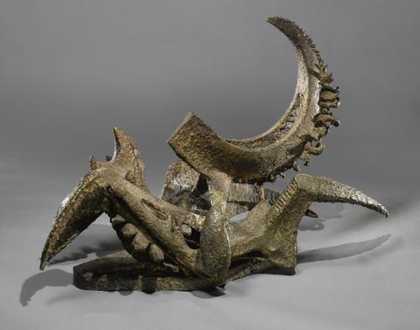
Fig.8
Theodore Roszak
Recollections of the Southwest 1948
Private collection
© The estate of Theodore Roszak
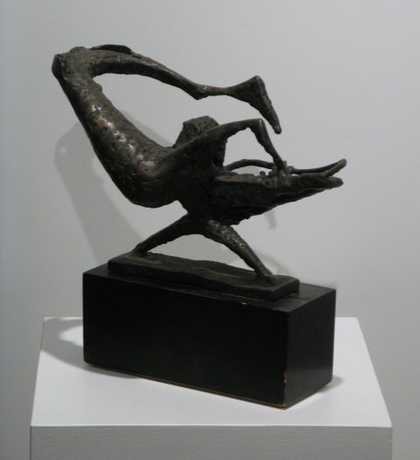
Fig.9
Theodore Roszak
Surge 1946
Location unknown
© The estate of Theodore Roszak
The encrusted appearance of Roszak’s sculptures particularly encouraged viewers to imagine his abstracted creatures to have emerged from the depths of the ocean. ‘Mr Roszak’, wrote French critic George Besson, ‘has fished out of the great funds of the Pacific the cadavers of petrified octopuses, shark jaws wound with algae, and metallic debris crowned with various shells.’27 For another critic writing in the New York Times, Roszak’s sculpture appeared like a ‘monstrous prehistoric crustacean preserved for all time in a sheath of bronze, steel and copper’.28 The title of Roszak’s Sea Quarry 1950 probably encouraged such analogies, but the artist also revealed that his claw-like sculpture Surge 1946 (fig.9) had been inspired by a photograph taken by Jacques Cousteau, whose underwater documentaries would help spawn cinematic fantasies like Disney’s 1954 adaptation of Jules Vernes’s 20,000 Leagues Under the Sea and It Came from Beneath the Sea (1955).29
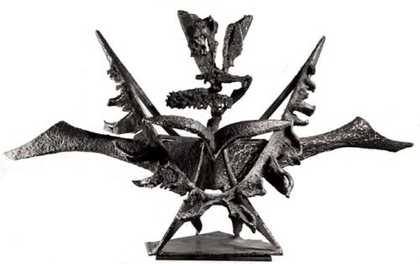
Fig.10
Theodore Roszak
Mandrake 1951
Cleveland Museum of Art, Cleveland
© The estate of Theodore Roszak
In the case of The Unknown Political Prisoner (Defiant and Triumphant) 1952, its gnarled, bark-like effects do not suggest barnacles as much as they do some kind of melding of animal and vegetal forms. The slightly earlier Mandrake 1951 (fig.10) represents Roszak’s most explicitly anthropomorphised plant form. As curator Edward Henning explained of the mythological status of the mandrake in his account of this work, this is a species that ‘grows with forked roots causing it to bear a rough resemblance to the human figure, and it is fabled to emit a terrifying shriek as it is torn from the earth’.30 Later in the 1950s Roszak made such hybrid possibilities explicit with the title of his work Insect Plant 1957 (fig.11). Sculptures such as these demand from their viewer an imaginative response, a context in which they might indeed come to life. As art historian Kenneth Sawyer wrote in 1958, ‘One always has the uneasy sense that a Roszak sculpture may at any time writhe into its antonymic shape’.31
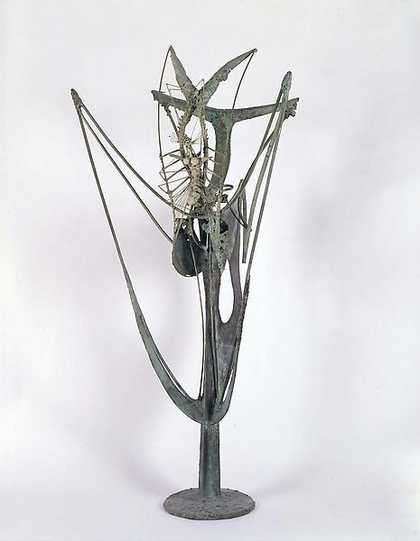
Fig.11
Theodore Roszak
Insect Plant 1957
Theodore Roszak Estate, New York
© The estate of Theodore Roszak
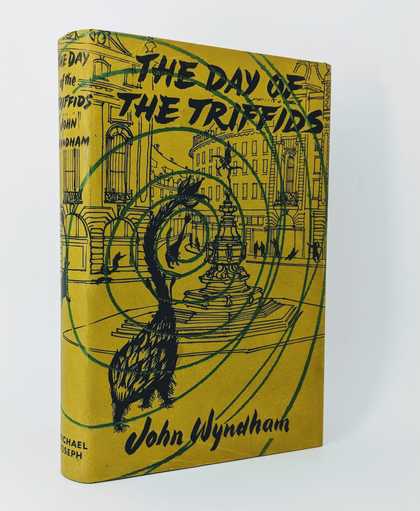
Fig.12
Cover of the British edition of John Wyndham’s The Day of the Triffids (1951)
The idea that Roszak’s sculptures might suddenly become animate was, I would suggest, coded into their material handling and their metamorphic imagery. For British viewers, one contemporary reference that Roszak’s sculpture might have easily evoked was John Wyndham’s novel The Day of the Triffids (1951). Resulting from a botched Russian experiment, the plant-animal hybrids of Wyndham’s narrative functioned as a barely masked metaphor for atomic-era anxieties. Wyndham cast the Triffids as potent symbols of catastrophe and mutation, of ‘harbingers of worse to come if the world did not mend its ways’.32 The book’s British cover design (fig.12) depicts one of the three-legged creatures striding through Piccadilly Circus in London, passing below Alfred Gilbert’s winged figure of Eros.
Wyndham’s lumbering tripod-legged beast is clearly brawnier than Roszak’s more lithe creature, which is poised on the verge of takeoff. But both monsters emerge from the same historical moment, one in which hybrid creatures were acquiring a new and urgent force in the popular visual imagination. As writer Susan Sontag explained in her essay ‘The Imagination of Disaster’ (1965), the rise of science-fiction films in the 1950s went further than their literary counterparts by providing the ‘images and sounds, not words that have to be translated by the imagination, that one can participate in the fantasy of living through one’s own death and more, the death of cities, the destruction of humanity itself’.33
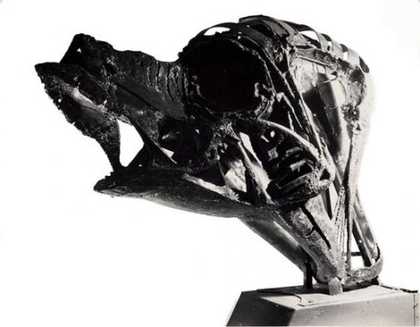
Fig.13
Theodore Roszak
Iron Throat 1959
Theodore Roszak Estate, New York
© The estate of Theodore Roszak
Post-war science fiction was distinguished from earlier incarnations of the genre by its persistent fear of nuclear blasts, fallout and radiation. As Sontag explained: ‘Beside these new anxieties about physical disaster, the prospect of universal mutilation and even annihilation, the science fiction films reflect powerful anxieties about the condition of the individual psyche’.34 In this regard Roszak’s melding of the body and the machine can be seen to interact with a broader 1950s visual culture concerning mutation and deformity. The title of Roszak’s Iron Throat 1959 (fig.13) certainly uses the metaphorical hybrid between metal and flesh to suggest such horrors (as in an ‘iron fist’), but it might also be connected to another more historically specific anxiety. ‘In the 1950s, images of iron lungs appeared everywhere’, notes one historian of science-fiction film, proposing a connection between the contemporary polio epidemic and a flurry of ‘films about brain eating parasites and aliens’.35
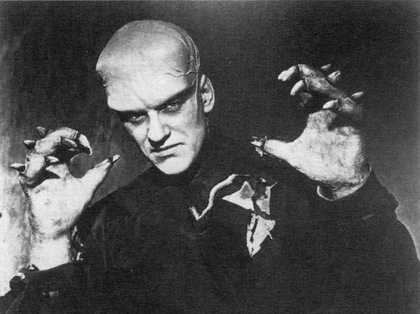
Fig.14
The Thing from Another World (1951) (film still)
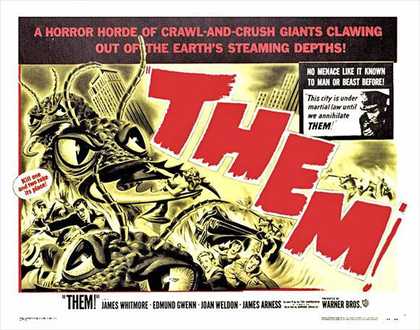
Fig.15
Promotional poster for Them! (1954)
Building on literary prototypes like The Day of the Triffids (which would itself be adapted for the big screen in 1962), the arrival of that category of films in which, as Sontag summarised, ‘some class of plants or animals which turn carnivorous and go on a rampage’ was most unmistakably marked by Howard Hawks’s The Thing from Another World (1951).36 Following the attack of a ‘vegetable with a brain’, the titular character arrives by flying saucer to grow an army of thorn-fingered monsters intent on devouring the human race (fig.14). The plot would set the format for many science-fiction films that followed. As early as 1953 the New York Times could describe Warner Brothers’ forthcoming film Them! (fig.15) with weary familiarity as ‘a science fiction saga, dealing with giant ants, mutants of the ordinary, non-terrifying Formicidae, who get that way – you guessed it – as a result of atomic explosions’.37 Roszak’s rising prominence in the early 1950s alongside such narratives provided added charge to his creations.
The post-atomic nature-gone-bezerk genre would reach its apotheosis later in the decade in science-fiction classics such as Invasion of the Body Snatchers (1956). By the time of Roger Corman’s The Little Shop of Horrors (1960) the setup was familiar enough to be able to sustain parody. In the late 1940s and early 1950s, Roszak’s charred, mutant creatures represented a powerful expression of millenarian anxieties. But even by the mid-1950s, their allusions were more likely to themselves seem formulaic and even predictable. In part, this was perhaps the result of an epidemic of thorny, oozing monsters in popular culture that managed to make Roszak’s once startlingly inventive creations look passé, even kitsch. For instance, in 1956 the artist Patrick Heron described the dominant style of the International Sculpture Competition, in which Roszak’s work was included, in the following terms:
the weak frenzy, the tortuous, unreal complexities of a new expressionism, dark and thorny with fashionable doubts and fears, giving birth to bleak, anaemic or turgid forms which spring as much from formal inaptitudes as from any genuine, compelling Angst ... it seemed to me that the repetitive spikiness of all those iron thorns and cacti (preferably already showing signs of rust...) were a thin cliché by now.38
By the end of the decade, the New Images of Man exhibition, held in 1959 at New York’s Museum of Modern Art, and which included Roszak’s Iron Throat alongside work by Eduardo Paolozzi, Germaine Richier, Lynn Chadwick, Kenneth Armitage and Reg Butler, was lampooned as the ‘monster show’.39 Critic and painter Fairfield Porter’s review of Roszak’s work in 1953 had understood their ‘ambiguity between insect and animal, between animal and plant, and almost between organic and inorganic’ to ‘communicate horror’.40 But by the time of New Images of Man, Porter would dismiss its ‘monsters of mutilation’ as ‘superficial’.41 It is ‘less an exhibition for people interested in painting and sculpture than an entertainment for moralists’, he wrote.42 Roszak’s work exemplified the character of the show. Under the headline ‘Shock Sculpture’, his Iron Throat was described by one journalist as ‘screaming in terror’, a ‘trapped, tortured creature, hopeless and unspeakably ugly ... deformed, mutilated, stretched on an invisible rack, and reduced to a hideous screaming scull’.43 A critic for the New York Times understood the exhibition in similarly hyperbolic terms: ‘If the exhibition had a soundtrack, it would be a cacophonous medley of anguished cries and screeches and the quiet sighs of sobs of loneliness and longing’, imagining its silent figurative forms as the equal of Hollywood’s most overblown sound effects.44
Such relations are far from straightforward, and should not distract from Roszak’s own persistently philosophical bent, but the distance between popular science fiction and more intellectual responses to the fears about the future of humanity is also somewhat narrower than is usually recognised. Take Carl Jung, for example, whose attention to the significance of ‘primordial images’ turned in the late 1950s to the subject of flying saucers, a modern myth that he regarded as a contemporary trope for dealing with nuclear-era anxieties.45 Or recall philosopher Theodor Adorno’s 1953 essay ‘The Stars Down to Earth’, in which he worries that the ‘childishly monstrous scientific fantasies’ describe subjects ‘expecting from the transfigured shape of society misplaced in the skies an answer that only a study of real society can give’.46 In very different ways, theorists such as these understood that the fantasies of science fiction provided valuable insights into the conditions of post-war society.
Far from diminishing Roszak’s sculptural achievements, connecting his post-war work to the tropes of post-war science fiction might even help account for the fall from art historical favour from which his work has suffered. ‘For a time it seemed that Theodore Roszak would provide an alternative for the powerful precedent of cubism’, wrote art historian Kenneth Sawyer of Roszak’s work in 1958. But Sawyer’s revised judgements were prompted by the sense that his works drew on images that were hackneyed or commonplace. ‘There is a straining after effects, and attempt to pump vitality and drama into forms uninteresting because overfamiliar’, Sawyer complained.47 The fact that, by the end of the 1950s, Roszak’s art looked strained and formulaic owed something, I suspect, to the proliferation of creatures of some kind of ‘terrible mutation’ that appeared on the covers of pulp fiction and its cinematic offspring.48
Roszak’s intellectual tastes usually tilted towards the highbrow, but he would eventually also attend to the mutual relations between art and mass culture. Writing in 1965, he could certainly decry the ‘commercialism that indiscriminately uses and manipulates ideas, art, commodities and human lives by dumping them mercilessly in the same automated hopper’.49 He even thought that mass culture exhibited ‘parasitic effects’, choosing a phrase so redolent of his own sculptural style that it might allude to his own entanglement in mass culture’s voracious appetite for the avant-garde. But he also admitted, in the same essay, that artists had to ‘recognize ... the total American scene’ in order to free themselves of ‘European dependence’. In so far it defined America, popular culture required artistic recognition. ‘The flexible working state of democracy both supports and restrains the reciprocal movement of our evolving cultural patterns that ultimately are made easily available to everyone’, he explained.50 The connections between the myths of science fiction and Roszak’s sculpture rely on precisely such evolving and reciprocal relations, supporting each other’s fantasies, but also restraining their impact.
